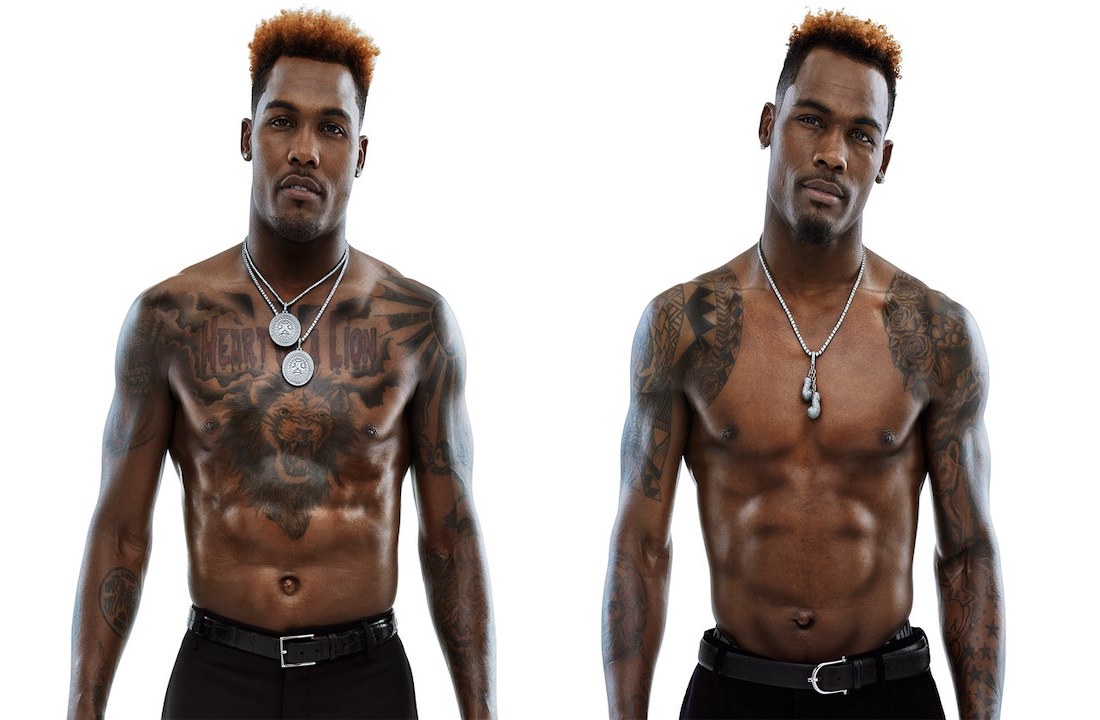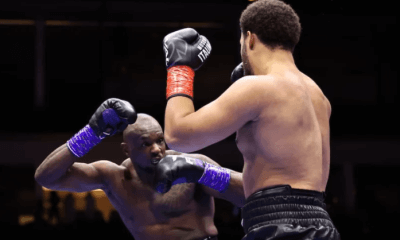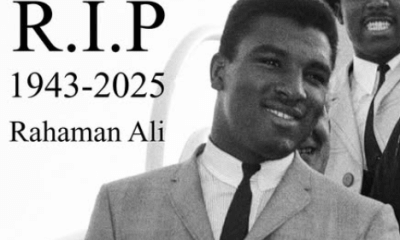Featured Articles
The Hauser Report: Jermell and Jermall Charlo on Fox

On December 22, the Charlo twins – Jermell and Jermall – fought Tony Harrison and Matt Korobov at Barclays Center in Brooklyn.
The Charlos are 28 years old and have been fighting professionally for ten years.
Jermell entered the ring with a 31-0 (15 KOs) record and was the reigning WBC 154-pound beltholder. He shone brightly in a first-round demolition of Erickson Lubin last year.
Jermall had compiled a 27-0, (21 KOs) record. He previously held the IBF 154-pound title and now campaigns as a middleweight. A 2016 decision over a faded Austin Trout was the most notable victory on his ring ledger.
Everything seems personal for the Charlos. It’s hard to imagine either brother outsourcing revenge to the other (as Vitali and Wladimir Klitschko did on several occasions) and finding satisfaction in payback that wasn’t beaten out with his own fists.
Jermell vs. Tony Harrison and Jermall vs. Matt Korobov were thought to be stay-busy Christmas presents for the Charlos. Neither brother gives an opponent much to work with. They’re good defensive fighters who strike swiftly when opportunity beckons. Jermell was a 10-to-1 betting favorite over Harrison while Jermall was listed at 20-to-1 over Korobov.
Several disquieting themes underlay the promotion. The first of these revolved around the fact that, on November 1, both Charlos “missed” tests that were to be administered by the Voluntary Anti-Doping Association (VADA) pursuant to the WBC Clean Boxing Program. Initially, the New York State Athletic Commission sought to distance itself from the issue, saying that the WBC-VADA tests were “separate from the New York State Athletic Commission’s Rules & Regulations.” But that was an untenable position.
Piecing together from multiple sources what happened next, the NYSAC then asked the Charlos for a more detailed explanation of why they’d missed their tests and failed to answer their cellphones on November 1. Previously, Jermall had tweeted that the brothers had been doing “promotional stuff.” But the commission didn’t get an adequate response. Instead, it was suggested from above that the commission back off on requiring the Charlos to document the reason why they’d missed the tests and, instead, administer new tests. In today’s world of microdosing, this passes for a bad joke. And the joke became even less funny when the NYSAC had one brother’s test administered by Quest Diagnostics and the other brother’s test administered by Lab Corp.
Quest Diagnostics and Lab Corp can tell the difference between blood and urine. But they don’t do state-of-the-art testing (such as carbon isotope ratio testing) for banned performance enhancing drugs.
On December 14, Greg Leon of Boxing Talk interviewed Tony Harrison and told him, “I’ve got to ask what you think about the Charlo’s, who have two different coaches, missing drug tests on the same day?”
Harrison gave a vague response.
“Allow me to ask the question in a different way,” Leon pressed. “If you were the champion, would you ever defend your title against a challenger who missed a drug test?”
“No,” Harrison answered. “Honestly, I would not. It leaves too much of a gray area. I wouldn’t do it, but it’s out of my hands. There’s literally nothing I can do. I just have to take it for how it is, man, the life of being a B-side fighter.”
Then, on December 15, it was revealed that Willie Monroe Jr, who’d been scheduled to fight Jermall Charlo on December 22, had tested positive after taking a banned supplement called Nugenix (a testosterone booster). Monroe was removed from the card and replaced by Matt Korobov, which sent the message that, in New York, fighters who might be dirty should simply miss tests and they’ll be allowed to fight.
Four years ago, the New York State Athletic Commission said that it wouldn’t license Korobov to box because of what it termed a congenital brain condition. Some other jurisdictions don’t consider this particular condition to be a potential danger and, subsequent to New York’s decision, granted Korobov a license to box. To date, the NYSAC has refused to explain when it changed its standard on this issue and the reason for the change.
Finally, when asked about Monroe at a December 19 media workout, Jermall and Jermell Charlo engaged in what one might consider an exercise in hypocrisy.
“Cheaters never win,” Jermall offered.
Jermell was more expansive, proclaiming, “They should suspend him from boxing. Monroe shouldn’t be allowed to come back. I’m glad they was able to catch this beforehand. It sucks that someone would cheat, and they know that they’re cheating. We need the sport to be cleaned up. Take all his bread. Take them away from the sport. They shouldn’t be allowed back. They should be banned for life and probably sentenced to a jail sentence or something. Yeah, send their ass to jail!”
Bottom line: Jermall Charlo vs. Matt Korobov at Barclays Center on December 22 matched a fighter who missed a PED test in November under questionable circumstances against a fighter who, four years ago, was unable to obtain a license to box in New York because of a congenital brain condition.
When fight night arrived, Jermell Charlo vs. Tony Harrison was a tedious tactical encounter. Harrison fought much of the bout like a man who would be happy to survive for twelve rounds, pick up his paycheck, and go home. The general consensus was that Jermell won nine of the twelve rounds. Jimmy Lennon Jr. announced that there was a unanimous decision and read the three judges’ scorecards: 116-112 (Robin Taylor), 115-113 (Ron McNair), and 115-113 (Julie Lederman). That left people wondering how two judges could each have given Harrison five rounds. The wonderment then turned to disbelief when Lennon uttered the words “And the new WBC super-welterweight champion of the world . . .”
Ironically, the Charlo-Harrison decision went against the house fighter. This suggests that poor judging rather than corruption was at its core.
In the nightcap, Jermall Charlo pounded out a unanimous decison victory over Matt Korobov by a 119-108, 116-112, 116-112 margin. Jermall won the fight, but 119-108 was off the mark.
Perhaps the most notable thing about the December 22 fight card was that it marked the inaugural telecast of boxing under a recently-negotiated contract between Premier Boxing Champions and Fox.
On September 5, 2018, PBC and Fox announced a four-year-deal that calls for the Fox broadcast network to air ten “marquee” fight cards per year with an additional twelve cards being shown annually on FS1 and Fox Deportes. The announcement held out the promise of championship-caliber boxing on a free platform. Thus, a lot of fight fans were disappointed on November 13 when Fox announced its fight schedule through March 16, 2019.
The two Charlo fights were joined on December 22 with a 20-to-1 match-up between Dominic Breazeale and Carlos Negron. January 26, 2019, will feature Keith Thurman vs. Josesito Lopez with the odds currently favoring Thurman by 10-to-1. Virtually all of the PBC-Fox main events announced to date have what amounts to a designated winner and a designated loser.
Let’s draw an analogy to another sport. Fox televises Big Ten college football. The schedule for the first four months of its boxing series is equivalent to televising Michigan vs. Rutgers and Ohio State vs. Minnesota again and again and never getting to Penn State vs. Wisconsin or Michigan vs. Ohio State.
The core of the Fox commentating team handled itself well during the first telecast. There were too many voices. But Kenny Albert handled blow-by-blow chores smoothly. Joe Goossen and Ray Mancini have been in the trenches. And Lennox Lewis adds dignity and class to anything he touches.
The use of Larry Hazzard as Fox’s “rules expert and unofficial scorer” raises an interesting issue. Harold Lederman resigned as a ring judge in New York when he took a commentating position with HBO. So did Steve Weisfeld when Weisfeld worked as a rules expert for HBO. Hazzard is commissioner of the New Jersey State Athletic Control Board. And his son, Larry Hazzard Jr, was the judge who scored Charlo-Korobov 119-108 in favor of Jermall.
But for boxing fans, the more important issue is this:
For all the money that’s being put into the system now by Fox, ESPN, DAZN, and Showtime, we should be seeing better fights than we’re seeing. Each of the networks maintains that quality control is built into its respective output deal with its favored promoter or promoters. But in today’s world, when “quality control” is measured in terms of “championship” belts and top-ten rankings, it means nothing.
Championship belts are dispensed today like chocolates from a vending machine. There’s a never-ending supply of bogus beltholders and undeserving “mandatory” challengers for elite fighters to fight.
Thus, 2018 is ending on a bittersweet note. There’s more boxing on television and streaming video now than ever before. But sadly, there are fewer great fights. And that’s unlikely to change in the near future. Every promoter, TV network, and sanctioning body of note has its own fiefdom (or “league,” if you will) that it’s anxious to protect to the overall detriment of the sport. If baseball were run like boxing, there wouldn’t have been a World Series this year. Instead, the Boston Red Sox would have been declared “American League World Champions,” the Los Angeles Dodgers would have been designated “National League World champions,” and baseball would be a niche sport.
Thomas Hauser’s new email address is thomashauserwriter@gmail.com. His most recent book – Protect Yourself at All Times – was published by the University of Arkansas Press. In 2004, the Boxing Writers Association of America honored Hauser with the Nat Fleischer Award for career excellence in boxing journalism.
Check out more boxing news on video at The Boxing Channel
To comment on this article in The Fight Forum, CLICK HERE
-

 Featured Articles4 weeks ago
Featured Articles4 weeks agoThe Hauser Report: Zayas-Garcia, Pacquiao, Usyk, and the NYSAC
-

 Featured Articles3 weeks ago
Featured Articles3 weeks agoOscar Duarte and Regis Prograis Prevail on an Action-Packed Fight Card in Chicago
-

 Featured Articles2 weeks ago
Featured Articles2 weeks agoThe Hauser Report: Cinematic and Literary Notes
-

 Book Review2 weeks ago
Book Review2 weeks agoMark Kriegel’s New Book About Mike Tyson is a Must-Read
-

 Featured Articles4 weeks ago
Featured Articles4 weeks agoRemembering Dwight Muhammad Qawi (1953-2025) and his Triumphant Return to Prison
-

 Featured Articles7 days ago
Featured Articles7 days agoMoses Itauma Continues his Rapid Rise; Steamrolls Dillian Whyte in Riyadh
-

 Featured Articles3 weeks ago
Featured Articles3 weeks agoRahaman Ali (1943-2025)
-

 Featured Articles3 weeks ago
Featured Articles3 weeks agoTop Rank Boxing is in Limbo, but that Hasn’t Benched Robert Garcia’s Up-and-Comers



















